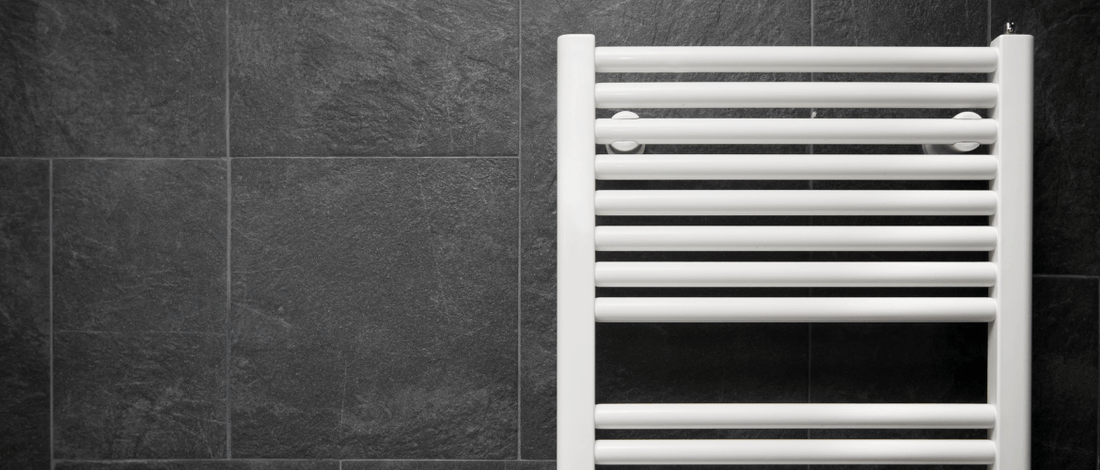
Bathroom radiator guide Which bathroom heater is the best
Share
A warm bathroom is more than just comfort - it is quality of life, especially on cold days. The right bathroom radiator not only ensures cozy temperatures, but often also serves as a towel warmer and design object. But with so many models, sizes and technologies to choose from, it's not easy: electric or water-operated? Flat, curved or design-oriented? In this guide, you will find out what types of bathroom heaters there are, what you should look out for when buying and which solution is really the best for your bathroom.
Electric or water-bearing? The heating types in comparison
The first big decision concerns the heating technology: do you want to connect your bathroom radiator to the central heating system or operate it electrically independently?
Water-bearing bathroom radiators are connected to the central heating system. They are energy-efficient if a well-functioning heating system is already in place and can be ideally integrated into existing heating circuits. Disadvantage: They only work when the main heating system is active - this can be problematic on cool summer days.
Electric radiators are independent and flexible. They are particularly suitable for guest WCs, renovated old buildings or transitional periods when central heating is not required. Modern models with a thermostat or timer are energy-efficient and easy to control.
Combination appliances offer the best of both worlds: They are connected to the central heating system, but can also be operated electrically - ideal for year-round comfort.
Conclusion: Your decision should depend on the structural conditions, your heating behavior and your comfort requirements.

Shape, design and dimensions: how the radiator fits perfectly into the bathroom
Bathroom radiators are no longer just white and functional. Today, they are a central design element in the bathroom - and should match the room both visually and practically.
Classic tubular radiatorsoften with curved or flat crossbars, offer space for hanging and drying towels. They are particularly popular as they combine functionality and aesthetics.
Designer radiators rely on clear lines, asymmetrical shapes or eye-catching colors. They fit perfectly into modern bathrooms where the heater can be a stylish statement.
Vertical models are space-saving and are well suited to narrow walls. They make the bathroom appear larger and are often very efficient.
Dimensions are crucial: Measure your wall area precisely and take into account the distance to the shower, washbasin or door. The required heat output also depends on the size of the room - a specialist consultant or an online calculator can help here.
Important: Even small details such as valves or the position of the connections should match the selected model and installation.
Performance & energy efficiency: How powerful does your bathroom radiator need to be?
A stylish radiator is of little use if it does not heat the room sufficiently. The heat output - specified in watts - is therefore a key selection criterion.
The rule of thumb: approx. 100 watts of heating power are required per square meter. For an average-sized bathroom (6-8 m²), the radiator should therefore provide around 600-800 watts. In old buildings with poor insulation, more may be required.
Influencing factors: Room size, window area, ceiling height and insulation standard have a major influence on the heat requirement. Whether you use the radiator as the sole source of heat or only as a supplement also plays a role.
Energy-efficient models with thermostat, timer or smart home connection help to optimize consumption. Electrical appliances in particular benefit from precise control, as they only heat when necessary.
Tip: Don't just let the appearance or size explain the heating capacity - always pay attention to the technical data! Many manufacturers offer heat load calculators on their websites to help you find the right model.

Installation and connection: What you need to look out for during installation
Installing a bathroom radiator is not rocket science - but it should be well prepared. There are different requirements depending on the model and heating system.
Water-bearing radiators require a connection to the central heating system. Attention must be paid to the position of the supply and return pipes. Many models are designed for the so-called central connection, which enables a clean and space-saving installation.
Electric radiators are usually simply connected to the mains supply. Important: The connection should be carried out by a specialist, especially in damp rooms such as the bathroom. A permanently installed heating element with integrated thermostat ensures safe and convenient use.
Combi models require both water and electricity connections. They offer a high degree of flexibility, but are somewhat more demanding to install.
Wall-mounted or free-standing? Most radiators are wall-mounted, which saves space. However, there are also free-standing models for particularly large or luxurious bathrooms.
Tip: Clarify with an installer at an early stage whether your connections are suitable for your desired model - this saves time and avoids unpleasant surprises.
Additional functions & smart features: more comfort in the bathroom
Modern bathroom radiators can do more than just heat - they offer smart functions that take comfort, efficiency and design to a new level.
Integrated towel rails or hangers are not only practical, but also visually appealing. They make it easy to dry or preheat towels - a plus for comfort, especially in winter.
Electronic thermostats allow you to control the temperature precisely. Even better: programmable models that allow you to define heating times - for example in the morning before showering and in the evening before going to bed.
Smart home connection makes it possible to control the radiator via app or voice command. This allows you to save energy while always enjoying the perfect room climate.
Timer functions and window open detection are now standard on high-quality appliances. They prevent unnecessary heating and reduce power consumption.
Design innovations such as glass radiators, mirror radiators or invisibly integrated systems offer exciting alternatives to the classic tubular radiator - perfect for anyone who wants an unusual design in the bathroom.
The bottom line: if you invest a little more, you get noticeably more comfort - and often also greater energy efficiency.
